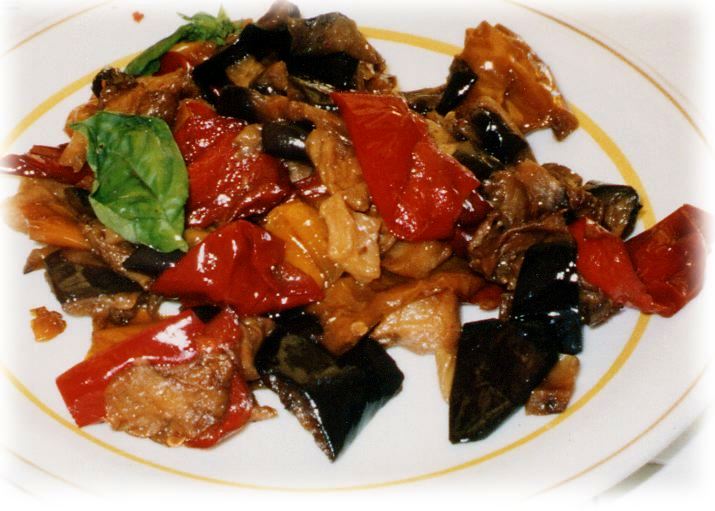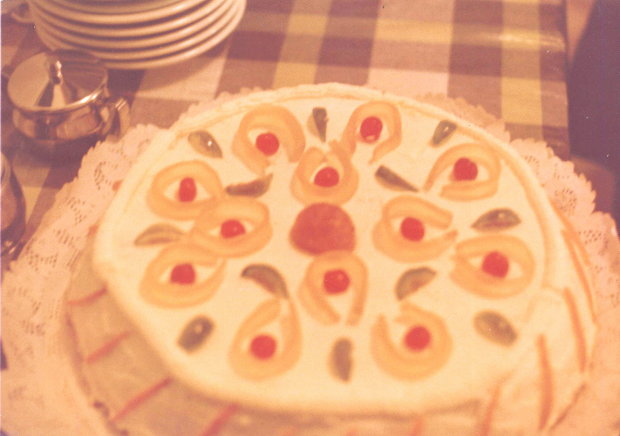
Lodovico's
list of recipes, included only after
having been repeteadly requested
Note the several
humorous links to images, added by
Gianni Grassi,
the super-active
webmaster who looks after the efficiency
of most of these web pages
Caponata (a typical sicilian vegetable mix: several variations allowed), see
top image
For six persons collect :
Eggplants 1 kg; onions 0.5 kg; tomato filets 0.5 kg; fresh celery 100 (cut
away the leaves), olive oil 100 gr; salted olives 100 gr; capers 50 gr; vinegar
150 cc; fresh basil and bits of sugar and salt
Cut eggplants in blockets - one inch square surface - and mix
them with salt…let them for some time under pressure, e.g. an heavy dish,
in a way so that they loose liquid. Slice the onions and fry them gently until
brownish, cover them with the tomato filets, add pieces of fresh celery, capers
and olives. Cook at length. Separately fry the eggplants after carefully drying
them. When brownish, add them with the vinegar to the tomatoes and cook gently
at length. When the vinegar is volatilized, mix the preparation with basil
leaves, dried sweet grape and pine-nuts. Serve when cool.
Anelletti alla Lodovico
This kind of pasta, shaped alike a ring
for your finger, is quite difficult to be found, specially outside the
Palermo-Trapani environment. Try to find any other kind which is easy to be
placed in layers AND be able to "incorporate" some sauce within
each individual (i.e. lasagne is not advisable). Indeed, the "thick"
tomato sauce described here below should deposit within the little hole of
each anelletto.
Prepare an abundant thick tomato sauce with heavy flavour of basil. The "heavy"
consistency is achieved by gently frying the onions with abundant carrots,
always cut as small as possible. The sauce is ready when you are no longer
able to distinguish pieces of onion, or carrot, or tomato…. Big samples
of basil may finally be extracted if they were joined to the sauce as such
(i.e. they will not "disappear")
Fry round, ½ inch thick or even just thinner, slices of eggplants,
so that they are almost hard at the end. The slices should be treated with
salt previously, so that much liquid is expelled.
The floor of a baking-pan is covered with a thin layer of tomato sauce. The
boiled anelletti (they should not be cooked till normal taste but left slightly
uncooked) are thrown as a first thin layer and then covered with the fried
eggplant slices which form a second layer. A third layer, of anelletti, is
covered with thin slices of "primo sale" (or any cheese which comes
from pure or mixed sheep milk ). Another layer of anelletti is followed by
another layer of fried eggplants and so on until you do no longer dispose
of the anelletti or the eggplant slices or the cheese. The stuff in the baking-pan
should be continuously pushed down to fill voids… After baking in the
oven, you obtain the anelletti
in the form of cake….Serve five minutes after taking it out from
oven.
Baked rice with mushroom sauce
Fry slowly and gently bacon with enough meat, onions, carrots previously cut
in small cubes…. until brownish. Add a reasonable amount of sausage meat
and keep cooking until each component has
disappeared…. Add now the mushrooms, originally dry, but left previously
in water so that they loose eventual grains (always present in dried mushrooms).
If the mushrooms appear too big, cut them in smaller pieces before mixing
them in the pan (i.e. is not pleasant to find yourself to manage a large piece
of mushroom in your mouth). Let the mix cook at length adding eventually the
water flavoured by the dried mushrooms. Add during the last five minutes white
wine; its quantity should not destroy the mushroom flavour......
Boil the rice - advertized as resisting to double cooking -
and when almost ready, dry it, mix with butter and parmisan cheese. Throw
the prepared rice into a baking pan after paving it with butter and then bread
crumble. The white rice should fill about 2/3 of the pan, building up side
walls so that the sauce, previously prepared, is layered down homogenously
to make a significant brownish layer, covered with the remaining reduced quantity
of rice… The liquid part of the sauce should slowly enter the underlying
rice, disorderly, so that the white rice is
randomly infiltrated by brownish lines…
Bake reasonably, hopefully obtaining a golden surface produced by the bread
crumble, which should ease either the getting out, in reverse, of the prepared
cake, or, if you use a baking pan with removable walls, the reversing operation
becomes still easier.
Pasticcio "Ferrara origin" modified Lodovico
Prepare "pasta frolla" ( = short or basic crust pastry) sufficient
to pave the floor of a baking-pan and its side wall, preferably smoothly inclined
to the exterior (similarly to \ ==== /). Be sure to have additional pastry
to squeeze a thin layer to cover the baking-pan after filling. "Pasta
frolla" is prepared as follows:
Mix 300 gr. flour, 150 gr sugar, 150 gr butter, two yolks and one full egg,
vanillin, and thin skin of a "young" lemon (grating delicately the
surface of a freshly collected lemon), half
a glass of marsala, or port, or red sweet vermouth, up to the point to
have a quite homogenous paste, a near as possible in the shape of a sphere.
It will be useful to cool it so that it becomes a hard ball, in the fridge,
where can be kept even for days. Some "specialists"
advice to avoid hands to mix the components, by using large knives or similar
tools until reaching quasi-homogeneity
Fry slowly in a pan, some bacon which should provide the meat component for
the sauce, onions, carrots and much much celery, all cut into small cubes.
When brownish, add much tomato in pieces or even tomato sauce (follow your
taste!), and let cook slowly for a long time. Ideally, no component of the
sauce should be distinguished. To add a clear savour to the sauce let the
sauce boil slowly with a big bunch of celery which should be taken away before
mixing with macaroni. Some humans dislike an intense celery flavour, so be
careful.
Mix this sauce to the boiled macaroni
type pasta (ideally "pennette" or "ditali") when not yet
definitely cooked (i.e. the final, proper cooking will be achieved later by
contact with the hot sauce and later in the oven). When cold, the macaroni
should be thrown into the previously prepared and laid down "pasta frolla",
onto the baking-pan.
.
The macaroni are well pushed within the cage and covered with a thin sheet
of the prepared "pasta frolla".
Cook in the oven for enough time (at least twenty minutes) to cook the pastry.
Serve 5 mins after exit of
the pan from the oven. Choose a pan with easily detachable walls, so that
only the bottom goes on the dish at the serving table
PS : one may wonder which detail modifies the Ferrara recipe. In Ferrara the
macaroni are accompanied by a "white" sauce, mainly besciamelle,
cooked ham and soft cheese….Here there is a "red" sauce, at
your liking flavoured with more or less celery "contrasting" the
sweet pastry (a weak attempt at "sweet & sour". Conversely,
see the Ferrara original recipe, the contrast is not sensed when the "white"
sauce accompanies the macaroni..
Meat-balls Lodovico's way
The slight, essential difference with the meat-balls preparation you have
always known consists in adding to the mix a reasonable number of little pepper
cubes, obtained by slightly frying them, cut from red, yellow and green peppers.
The varied colour appeals to the eyes, while the strikingly different flavour
helps - to Lodovico's quite personal taste - pleasure while eating meatballs.
Eggplants Parmisan way
Cut the eggplants perpendicularly to their elongation (i.e. round eggplants
are not advisable!) in roundish slices, and place them on towel throwing a
bit of thin salt on their surface (or else, place them in a container with
holes and alternate layers of them with little thin salt, pushing them down
with some weight). They should loose some liquid (mainly water). Fry them
gently (not completely...). In the mean time, prepare(or buy) a tasty tomato
sauce and cut thin slices of flavoured cheese (e.g. Edam). Then form layers
of fried eggplants, wettened with tomato sauce and covered by a reasonable
number of thin slices of cheese. Add layers until you fill a rather large
pan and exaust the quantity of eggplant slices, cheese and tomato sauce; cook
in an oven at medium temperature. You will smell the moment they are OK.
Sicilian CASSATA (beware, it is a dessert cake, NOT an icecream), version Lodovico (see image below, and more by clicking here)
Have a sponge cake available (buy in the shop or see below), 1 kg ricotta cheese (possibly from sheep), ½ kg sugar, a good tablet (up to 200 gr) of pure chocolate (no milk chocolate !) and a reasonable amount of thin orange skin, previously boiled couple of times, and a third time with a spoon of sugar. Cut the surplus white support for the orange skin.
Mix the ricotta with the sugar and leave it for 24 hours. Then put the lot through a sieve to obtain a paste without discontinuities or little lumps. Separate 1/10 of this pastry (it will be used later) from the main amount. Cut both the orange skin and the chocolate in small pieces and mix with the 9/10 of the ricotta pastry so that you see a reasonable number of brown and orange bits alternating here and there within the white pastry.
Cut the obtained sponge horizontally in three large round slices; cover one of them with the obtained ricotta mix. Build the wall of the cake by circling it by 4cm wide strips obtained from a second horizontal slice of the sponge. Complete filling up to level with the 9/10 ricotta pastry and cover with the third round slice of sponge, whose diameter should be reduced in comparison with the base of the cake so that the side slice should converge (i.e. it does not stand vertical…but inclined (similarly to /==== \) to the top of the cake. Cover the top and the wall with a thin layer of the (left aside) white 1/10 ricotta mix and add colour candied fruit (aligning, for example, thin "hair" of the orange skin on the side wall) to your liking to both top and side of the cake. In the traditional version the side of the cake is greenish, consisting of coloured almond pastry, reputed to add sweetness and rich, stodgy food without any relation with the ricotta flavour.
The sponge.
Have four eggs and the
weight of three of them (approx 200 gr.) in flour and in sugar.
Have 50 gr of baking powder. Mix eggs and sugar, very well, and join gently
flour and baking powder. Lay the whole mixture in a Baking-tin at about 180°C
for 35 mins.

Apologies for the bad quality of this photo, taken when the
team of local organizers prepared a dinner for the personnel
working
at the
Majorana Centre (until the early eighties). An additional series of images
- showing cakes prepared by Lodovico - is available.